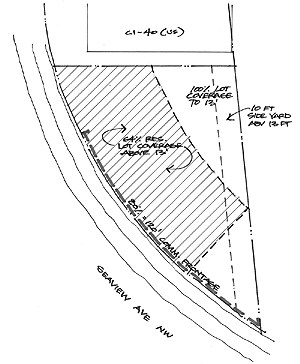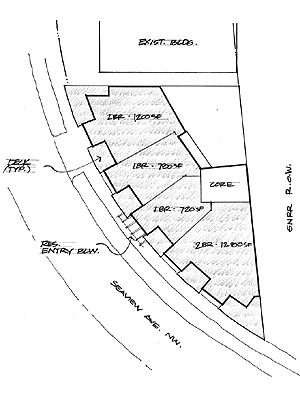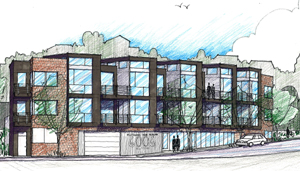
Surveys
DJC.COM
October 26, 2006
Getting creative with your feasibility analyses
Studio Meng Strazzara

Wharton
|
You’ve got the property under contract and your feasibility contingency is running out. Your appraiser has put a value on the land, you’ve got the surveyor’s map and environmental report, a market study is in hand, and your sales agent is giving you a pep talk about how he’s ready to sell, sell, sell. You know your investment requirements and risk tolerances. The seller’s agent is calling, eager to close the deal.
The numbers look good. You’re ready to go, right? Wrong.
There is something missing in all that due diligence, financial analysis and background research. Something that will determine whether or not you’ve effectively managed your risks, spent your money wisely and have any chance of success beyond pure accident. Without it, even the best property with the best pro forma and best risk management plan can fail spectacularly. As long as it’s missing, the chance that you’re leaving a lot of money on the table is very high.
Numbers can only tell you so much. A good quantitative analysis is essential, but can’t capture the value of a great development concept. To create a value-generating engine — such as Disney World on a formerly useless piece of Florida swampland or finding a way to beat your competitors on the same street — takes vision and creativity in the earliest analysis stages.
Not every project needs to be as ambitious as Disney World, but in today’s increasingly competitive market you need to take a creative approach to differentiate your properties. The earlier you start doing so, even at the site acquisition and feasibility stages, the greater your odds of success.
| Making a Ballard project feasible |

By the numbers, this unusually shaped site with many legal restrictions would only yield five dwelling units at the most.

Through creative feasibility analysis, a development strategy was identified which yields 10 dwelling units, doubling the value of the project. 
Images courtesy of Studio Meng Strazzara
The final design follows directly from the initial feasibility concept.
|
Creative feasibility analysis
That missing element is creative feasibility analysis.
Feasibility analysis is not the design of the project, though it very well may be undertaken by architects or other professional designers who think creatively about complex problems. Creative feasibility analysis is the conceptual identification of specific development strategies along with an analysis of how well they work given a set of goals and constraints.
When we say that a proposed project is feasible, we are really saying the concept fits best with the physical or other characteristics of a development site, limited time and resources, and the constellation of regulatory and other constraints. Finding that fit requires creativity in asking questions, determining the limits of constraints and finding solutions.
Asking the right questions can reveal opportunities through discovery of new development objectives and hidden value. Creative investigation of constraints can yield new ways to gain development flexibility and add value. Some examples include a technology to allow construction over an unstable slope, a novel parking layout that allows additional leasable space, or a code interpretation strategy that gains additional lot coverage or building height.
To bring all of these elements together into a cohesive and elegant development concept requires the most creativity of all.
None of those things can be revealed or accomplished by a traditional quantitative feasibility study. If it’s done right, the end result is a clear and compelling vision for the project, one that can be used as the basis for a full pro forma, getting project financing, effectively managing risk, quickly obtaining project entitlements, and creating the foundation for a successful design phase.
So, what should you look for in getting a creative feasibility analysis for your projects?
The final product should be a report including the following:
• An executive summary that identifies the major objectives, constraints, opportunities and assumptions used, as well as the bottom-line results from the concept studies.
• A compilation of information about the characteristics of the site and surrounding infrastructure, including some of the more traditional due-diligence information such as surveys and title reports.
• A full statement of development objectives, including business case priorities and any special success parameters.
• A statement of legal context, including easements, deed restrictions, a list of applicable regulatory jurisdictions and permitting requirements, a review of zoning and building codes, and other similar items.
• Concept studies and/or a concept master plan, in which specific development proposals are illustrated, described and evaluated for fit.
You may also wish to include a market study, merchandising plan and/or preliminary financial pro forma, depending on specific project requirements.
With a completed creative feasibility analysis in hand, you can move forward with confidence, knowing that you have thought through and obtained the vision to guide your decision-making and make your project successful. It will also become a useful tool in communicating your vision to others.
Gregory Wharton is a lead designer in residential, commercial and mixed-use architecture with Studio Meng Strazzara in Seattle. He performs creative feasibility analyses for developers.
Other Stories:
- Victoria project goes from brown to green
- Should design firms grow and change?
- Retail plays a bigger role in mixed-use
- In with the old, in with the new
- Designers bet urban dwellers want more
- Dream team designs downtown penthouses
- Designing a cancer center for 4 competitors
- Healthy buildings’ role in organic modernism
- Queen Anne readies for icons old and new
- Keeping the bad guys out of banks
- Surviving today’s tough bid climate
- Why marketing during the good times is critical
- Hotels and condos: mixed-use matrimony
- School’s design reflects its humanist curriculum
- Seattle’s waterfront: 100 years of hidden history
Copyright ©2009 Seattle Daily Journal and DJC.COM.
Comments? Questions? Contact us.